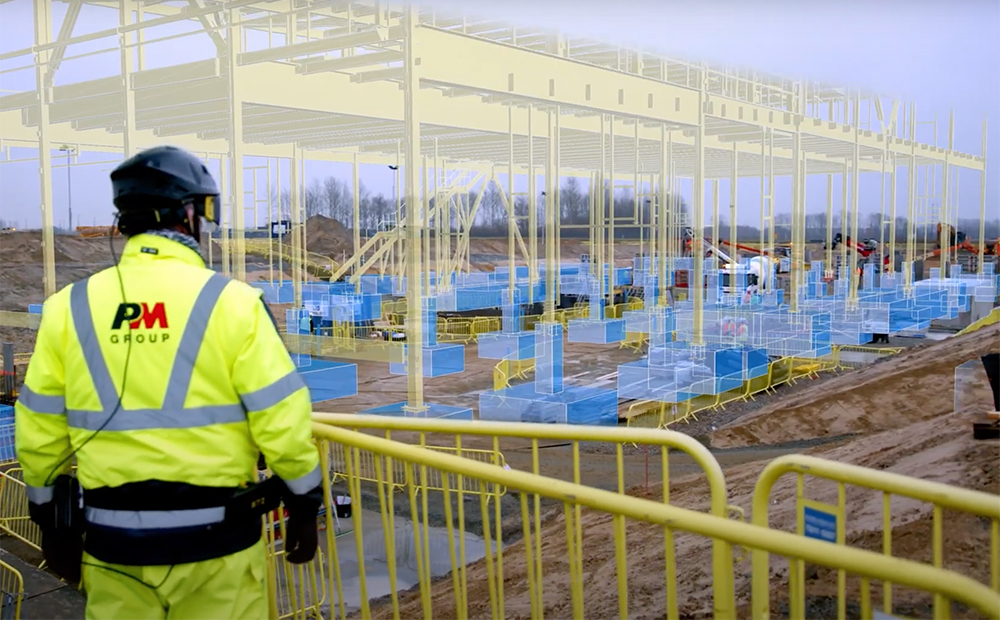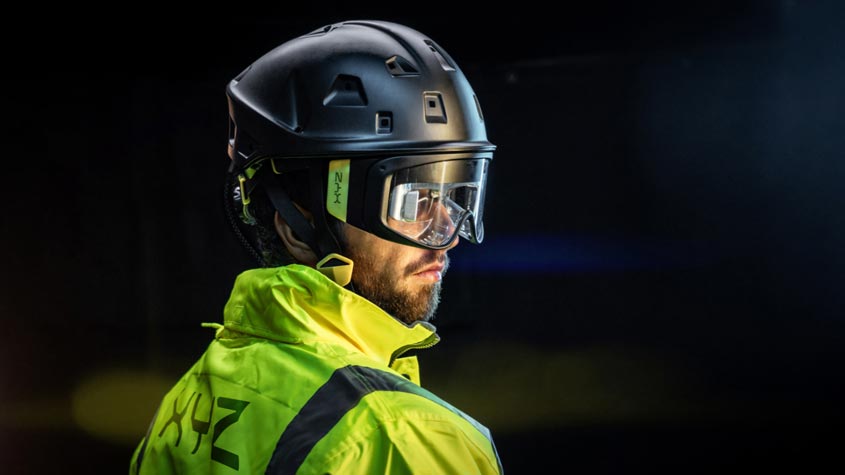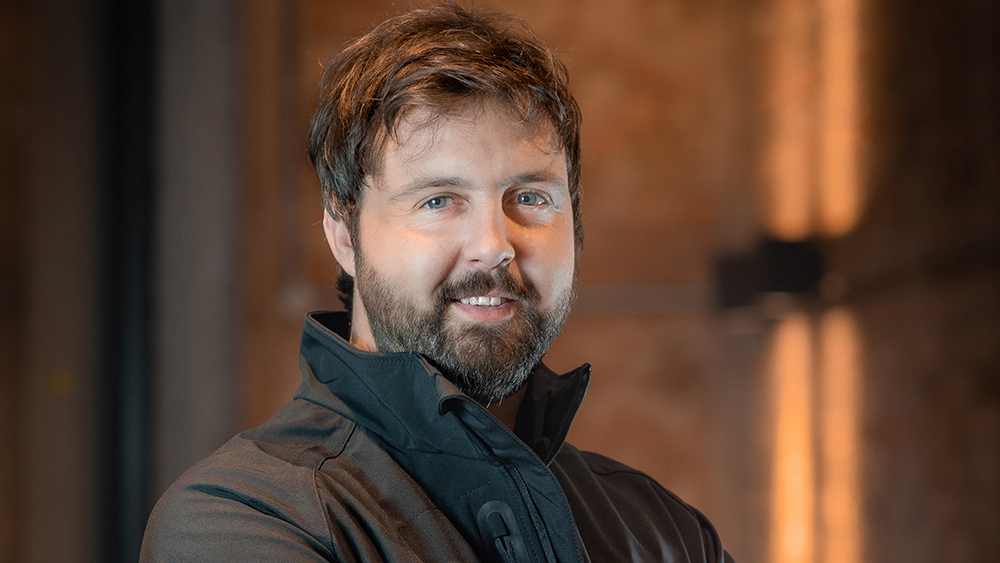
Former design manager David Mitchell says his new AR technology will be a game-changer for construction – and is already achieving cultural transformations onsite. Denise Chevin reports.
In 2017 David Mitchell set up XYZ Reality to develop an augmented reality (AR) headset for construction which allows those working on a major construction project to see the plans, projected in full-size 3D, in front of them with a margin of error of just 5mm.
And by allowing workers to see a hologram of the 3D design overlaid on to the work as built, HoloSite – as the technology is called – allows problems to be flagged up earlier, as well as improving the positioning of major building elements and reducing costs associated with errors.
Mitchell explains: “Imagine if you build a wall out by 200mm, that error starts to compound, because that wall is used as a point of reference for the next set of work. And that snowballs throughout the project. You regularly hear figures of 10% of the project cost being spent on rework.”
Mitchell says traditional tools for making a comparison, such as scan to BIM, are focused on a reactive method, where the damage is already done and the cost has already been incurred. “For the first time now, construction management teams can keep ahead of their works, and ensure they’re building to plan, and getting it right first time.
“There is a lot of tech in the market place, but much of that is building on top of 2D drawing workflows, which is like a patchwork quilt, they’re patching gaps. But what we consistently see with our solution is that it just makes sense, it’s very intuitive for people to use.”
‘I often thought drawings were difficult to interpret and understand. So I thought, if you could project the 3D image on site at a 1:1 scale, accurately, within construction tolerances, then why would you need 2D drawings?’
In June, the company announced it had raised £20m in investment for the headset and visor technology, and is working with University College London (UCL) to tailor its system specially to hospital construction.
Here, Mitchell tells BIM+ more about the plans.
What stage are you at with HoloSite?
“We’ve been deployed to projects worth more than £1.5bn across Europe. But this funding round allows us to expand our existing projects, it allows us to penetrate the US and grow our team, and it will allow us to launch our Gen2 headset this year.
“We’re working with selected clients on commercial basis and are measuring the impact the technology is having. It’s important to have proven, empirical data.
“Our business model is like the traditional tool-hiring process in that we provide a headset on a per unit per month subscription model.
“One of the projects it’s being used on is the construction of a £300m data centre in Denmark, where it is being used by PM Group. They initially started with three headsets, and they will be slowly ramping up with additional headsets. It’s critical that the data centre is completed on time and budget and we are confident that the investment in our technology will pay for itself over the course of a number of months.
“There is interest in our system in the pharmaceutical industry and following the partnership with UCL we announced recently, we want to help the public sector build hospitals and schools more efficiently.
“Later down the road we’ll then go into commercial construction, offices and high-rise residential and eventually domestic house building.”
How did the venture come about?
“I’ve been involved in construction from an early age. My father was a builder in the west coast of Ireland, I worked on a building site when I was younger and worked my way up the ranks from there. I did a degree in architecture and went into design management and BIM and worked in Paris for a time, before coming full circle back to major construction projects in London.

“I worked on the Shard, Battersea Power Station and a number of other major projects in the UK, mainly for J Coffey Construction. I came up with the proof of concept for paperless construction and left J Coffey to set up XYZ Reality in 2017. J Coffey Construction helped seed fund it.”
What gave you the idea?
“It came through my experience really. I always thought “why are we using these 2D drawings?” I often thought drawings were difficult to interpret and understand. And after studying architecture, sometimes I struggled to understand my own drawings, after coming back to them a week or two later.
“So I thought, if you could project the 3D image on site at a 1:1 scale, accurately, within construction tolerances, then why would you need 2D drawings?”
Who developed the technology?
“It was a combination of myself and a fantastic team around me. Initially I found my founding partners, and from there we headhunted the best talent in Europe. There was a lot of dating and dinners, trying to win people over. They were fun days! Now top talent is coming to us, and actively want to work for us.”
What’s the appetite like for backing start-ups in construction?
“If I had started it today, it would have been a much easier journey. But looking back four years, venture capitalists were very sceptical of the hardware, and especially of the construction sector. But the change in appetite is there to see now.”
Who would use the headset?
“It’s a range of users out in the field: the client may use it, or the project director, the construction managers, the foremen, the quality managers.
“But typically, it would be a construction manager walking around the site, who would be able to see if the ductwork is out of position, measure the deviation, and update the design team.
‘We’re actively targeting the higher levels of digital maturity initially, which you typically see in these mission critical projects and public sector works. In the longer term, I see it becoming more routine.’
“And that’s a game changer, because traditionally you wouldn’t have caught that error until two weeks later. With our system, the contractor can set about changing it. It allows the project to move forward with certainty, rather than waiting for the impact to hit further down the line.
“We are seeing subcontractors wanting to be involved too.
“Some errors do slip through the net, and we’ll work on that over time, hence the increase in the number of headsets on the projects. The more people that use this tech, and the more it’s distributed across the workforce, the greater the certainty you’re bringing to the project.”
Does it take much getting used to?
“That was always a cause for concern, but the key is that it’s 3D. And we’re 3D creatures, so it’s very familiar to us. Ensuring the safety of users is paramount, so we restricted the field of view so they could always see their peripheral vision, always see their feet.
“We’ve had glitches along the way, but we haven’t had any problems or pushback, which is great.”
Talk us through the project with UCL.
“The partnership enables us to second an expert from UCL to work alongside us to help develop HoloSite for use in healthcare.
“From a geometrical standpoint, positioning 3D information on site accurately is the same whatever the building type. But there are systems and processes that are built on top of that, eg issue management systems, hierarchies within these projects may vary. The contractual relations may vary, which then influences our processes and our software.”
Is it always going to be a tool for complex projects?
“We’re actively targeting the higher levels of digital maturity initially, which you typically see in these mission critical projects and public sector works.
“In the longer term I see it becoming more routine. I want to get it down to the price of a mobile phone, where it can be utilised across the industry. When you transition to building from holograms, that’s a different ball game, and a different set of safety features we need to consider. So it’s incremental steps.

“The thing I’m most proud of is the cultural mindset shift on site, where normally you’ve constantly got your back against the wall, fighting fires, installing works and you don’t know if they’re right until two weeks afterwards.
“But now they think ‘let’s get ahead of the work, and build it right first time’. They don’t have to wait two weeks; they can do it as they’re building. That’s the big mindset shift.”
What’s the next stage?
“Stage 1 for us is to be able to position a hologram out on the site to mm accuracy. We call that Engineering Grade Augmented Reality. That’s where we are now.
“The next stage in our journey is actually assisted reality. At the moment a user walks out on site and sees the real work, a column for instance, and they see a hologram column, which may be out by 200mm.
“With assisted reality, it’s like Tesla autopilot for construction. They go out with the same headset, and rather than them inspecting every element with their eyes with a hologram overlaid, the helmet will autonomously detect the deviation, and only flag it to you if it’s related to you in your role.
“Of course, the information displayed on site is only as accurate as the model. But what we’ve seen is that it actually produces a cultural change. It puts the onus on the designers to produce a more complete model. Everyone is getting more involved in the BIM journey on these projects, and they’re improving their systems and processes.
“On handover, that model is accurate, high fidelity, and it’s there to be leveraged as a digital twin effectively.”
















